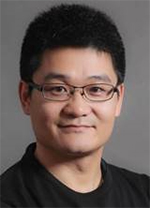Learning to see: from Big-data driven to X-Data driven
Abstract
AI needs to see the world as human beings in order to complete its missions smoothly. In the last 5 years, Computer Vision has made remarkable progress by leveraging ABC engines: Algorithms, Big-data, and Computing. In this talk, I will firstly introduce the recent progress in computer vision, which are mainly achieved by deep learning from big-data on GPU. Then, I will analyze that the ABC methodology is not enough to develop a seeing AI. We need learning algorithms that can learn from more complex data conditions, which is called by me X-data driven methods with X-data standing for small data, noisy data, weakly supervised data, semi-supervised data, and self-created or adaptively collected data. Some of the efforts to this direction in my lab will be introduced for discussion.
SpeakerProf. Shiguang Shan | |
Date & Time4 Jan 2018 (Thursday) 10:30 - 11:30 | |
VenueE12-G004 (University of Macau) | |
Organized byDepartment of Computer and Information Science |
Biography
 Shiguang Shan is now a Professor with the Institute of Computing Technology (ICT), Chinese Academy of Sciences (CAS), where he received the Ph.D. in computer science in 2004. He is now the deputy director of the Key Lab of Intelligent Information Processing of CAS. He is also the founder/Chairman/CTO of Seeta Tech. Inc. He published more than 200 academic papers in refereed journals and proceedings in the areas of Computer Vision and Pattern Recognition, and his work has been cited more than 12,000 times in Google scholar. He especially focuses on face recognition and deep learning related researches. He has served as Area Chair for a number of international conferences including ICCV’11, ICPR’12, ACCV’12, FG’13, ICPR’14, ICASSP’14, ACCV’16, and FG’18. He is Associate Editor of the IEEE Trans. on Image Processing, the Neurocomputing, the Journal of Computer Vision and Image Understanding, and Pattern Recognition Letters. He is the winner of the China’s State Natural Science Progress Awards in 2015 for his work on non-linear visual modeling and learning, the China’s State Scientific and Technological Progress Awards in 2005 for his work on face recognition technologies, and the Best Student Poster Award Runner-up in CVPR’08. He also won the NSFC excellent young scientific fund in 2012 and the CCF young scientist award in 2015.
Shiguang Shan is now a Professor with the Institute of Computing Technology (ICT), Chinese Academy of Sciences (CAS), where he received the Ph.D. in computer science in 2004. He is now the deputy director of the Key Lab of Intelligent Information Processing of CAS. He is also the founder/Chairman/CTO of Seeta Tech. Inc. He published more than 200 academic papers in refereed journals and proceedings in the areas of Computer Vision and Pattern Recognition, and his work has been cited more than 12,000 times in Google scholar. He especially focuses on face recognition and deep learning related researches. He has served as Area Chair for a number of international conferences including ICCV’11, ICPR’12, ACCV’12, FG’13, ICPR’14, ICASSP’14, ACCV’16, and FG’18. He is Associate Editor of the IEEE Trans. on Image Processing, the Neurocomputing, the Journal of Computer Vision and Image Understanding, and Pattern Recognition Letters. He is the winner of the China’s State Natural Science Progress Awards in 2015 for his work on non-linear visual modeling and learning, the China’s State Scientific and Technological Progress Awards in 2005 for his work on face recognition technologies, and the Best Student Poster Award Runner-up in CVPR’08. He also won the NSFC excellent young scientific fund in 2012 and the CCF young scientist award in 2015.
